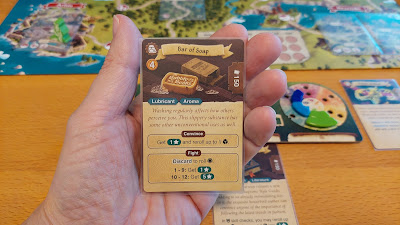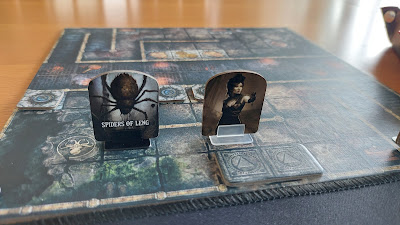Welcome to my continuing look at Machina Arcana. In Descent into Madness part 1 I commented on theme, art, atmosphere, variety and replayability, choices and smooth combat. If you want more information on those head over there - here we'll look at production quality, the standees, and publisher support, as well as some quibbles about the game.
Let's continue our descent...firstly with some more positives!
Production quality
One thing I really like in a game is that feeling that the money you invested has been well spent. For me (in part) that comes from the components. How do they feel in the hand? Are they durable and fit for purpose both in practical and game terms? Sometimes a first look at the game when you open the box fills you with wonder and excitement, but then, thin, warped player boards that spin around on the table (shedding meeples and cards!) really brings you down to earth.
No worries of that here! All of the key components are high-quality. That includes the card decks, custom dice, maps and player boards. And my goodness, those player boards and the chapter board are a fave of mine. Dual-layered, they hold your stat markers and character cards. Can those markers be knocked out? Sure, but the design stops things slipping around (as well as looking good too.) Take a look at the images below and also note the lovely theme and colours.
 |
Two-layered player boards hold character cards and track stats
|
 |
Two-layered chapter board tracks monster level and
the unfolding story as you make your way through each chapter. |
The high quality of the components extends through the game. The artwork is fantastic too (as mentioned in part 1.)
A special shout out to the designer of the component trays and the author/ publisher making this happen. They fit all of the components of the main game and the components from the two current expansion sets. This really helps with setup time and also reduces your overall financial investment in the game - you don't need to invest in a separate organiser or the time necessary to make your own foamboard solution. ALSO, it fits the cards even with sleeves on (although I'm not 100% sure if that is only for the official sleeve set and I don't know the sizes needed.) I haven't sleeved mine yet, but because I usually do, this is great to see.
For more information about how the trays work and the tray designer, visit Matt Healy and his page here at Mess AXP Game Inserts.
I do have a quibble about the trays, but I'll mention those below when we talk about some of the 'lows' of the game.
Standees
For me standees are big plus in a game, especially if the artwork is of good quality. I've painted lots of miniatures and I'm one of those people who prefers to start playing a game with the minis painted (no grey plastic!). That is a personal (weird?) choice, but it means that standees are a great option for getting a game to the table quickly with minimal effort. If you have limited painting time, experience, or confidence standees are a great option. When playing the game, I don't notice that I'm using standees and not miniatures - my imagination is in full swing.
 |
| Hank has left the map, and Kim is forced into a fighting retreat! |
Publisher support
A lot of credit must go to the author, Juraj Bilich for not only bringing his vision to the table, but also being active in supporting it. I've seen other author provide great support to their user base of course (Andrew Parks of Dungeon Alliance is a good example), but being able to get authoritative answers is reassuring and positive. Mr. Bilich is active on Facebook (at the Machina Arcana group) and also on the
Boardgame Geek Forums. This may be becoming more the norm, but it is appreciated none-the-less.
So between these positives and my first post, you can see that there is a whole lot to love for Machina Arcana. Of course, there are some quibbles too, so lets now talk about...
...the lows
Probably better to call these 'dips' rather than lows, as none of these are show stoppers or would prompt me to sell the game or not recommend it. However they are things to consider.
Limited content in the box
Firstly, there are 'only' three campaigns in the box, composed of a series of chapter cards that are lined up in order. You will come to know the story well as you reveal it. Each offers several hours of gameplay, and more if you decide to play with a reduced deck of chapter cards for a shorter game (as recommended by the rulebook). You will also have seen the final chapter of each story, including the story-ending map tile that is reserved for the ending.
Now, there is a lot of replayability, because you never know what map tiles will emerge, and there are plenty of character combinations to try. No two games will feel identical. There are two expansions (To Eternity, and From Beyond) available that add extra mechanics, new characters, and new campaigns (purchased separately).
 |
| End game special tiles. Not to be revealed early... |
 |
| Randomly-drawn double-sided map tiles provide replayability |
I've replayed the opening campaign many times, and the turn-to-turn gameplay still feels fresh. With four different character classes to mix and match you'll also find new challenges to think about when dealing with less robust characters or interesting party compositions.
Story and map disconnect
When playing, you sometimes feel a story disconnect. In a more traditional dungeon-crawler, you might drop a plastic treasure chest or token on the map as you reveal it (usually at the direction of a story guide or scenario setup), but the tile here has all elements pre-printed on. Remember that the story is revealed by the chapter cards as you play through, and the map tiles are drawn randomly. It can be the case that what is being described in the story has nothing to do with the tiles and what you see before you. In a way, this is a side effect of how successful the game is in drawing you into analysing the map tiles as you consider what is printed on each and how you will make your way across it.
 |
The maps are gorgeous with lots to interact with,
but due to the gameplay design they don't match the chapter story. |
Is this a deal-breaker? No. In my opinion this simply requires a mental reset for some players, who may be used to having a bookcase, an altar or a treasure chest in front of them as a mini or a map item.
Turn-by-turn repetition
The game can feel repetitive. This is a side effect of the 4-step turn process. For me personally this stopped being an issue once I realised that mastering the process led to a nice, quick game - when playing solo at least.
Spawn phase? Roll the dice, take the action based on that, move on.
Horror phase? Draw the card, do as listed, etc.
I'm not sure why, but it felt more repetitive than something like 'Mansions of Madness 2e'.
Fiddly rules
The glossy rulebook is laid out logically, and the sample gameplay walk-through was nicely done, but I still found some of the rules difficult to parse and apply. This held true for some monsters, chapter cards, and events. This can happen in any game, but I found myself resorting to Boardgamegeek and the M.A. Facebook group for help. I was able to quickly find answers (often from the author), but I did get frustrated at times. Sometimes the issue may come down to an interpretation of a gameplay word used, or edge cases caused by the monster A.I. ("Will the Ghast destroy a chapter space and if so, will that flip the chapter?") Upon re-reading the manual closely, I wasn't sure...
Tactical...but not?
From everything I've described, you might expect Machina Arcana to be really "Tactical". It has a map, a party and enemies that move around, limited actions to manage, upgrades to consider, and difficult choices to make. However, this game doesn't have some of the standard or traditional "Tactical" elements you might expect. For example...
...facing doesn't play any part in combat (that I can see). So far I haven't had to think about outflanking enemies.
...the rules as written don't include melee bonuses (e.g. based on supporting characters.)
Remember though that the game bills itself as a "Co-operative horror adventure board game". It doesn't bill itself as tactical. Personally, I find that there are so many important decisions to be made on a turn-by-turn basis that I don't miss the elements mentioned above. These would slow the game down and I don't think they would offer anything to the experience that the game is striving for.
Organiser issues
As stated earlier, the organiser is a big plus for the game, but one quibble is the flimsy plastic used. I'm not sure how this could have been avoided, but it looks as though it can split or crack really easily. Everything fits together really well, but very snugly. If you don't put the trays back in the right way, you can catch the edges of them, leading to cracks or splits.
I have other games with trays and I haven't noticed this as much. Roll Player Adventures also has a really good tray system included, but it feels just a bit more durable (although no thin-walled plastic is ever going to stand up well to rough handling!)
 |
Chit and monster trays. You can see them around the manual.
These have thin walls and the bottom lip can catch on other
components. |
 |
The main tray - space for everything! (Try to ignore the
horror that is my jumble of monster tokens...) |
The trays work great to organise everything, but be aware that they are not very durable. I'd much rather have them included than not though!
In summary...
...Machina Arcana is an excellent game that standards apart from most 'Dungeon crawl' games because of its theme, attention to detail, and story/ campaign presentation. I'm looking forward to playing more and working my way through everything. If you are looking for a Cthulu-related game of exploration and escape (combining horror and steampunk no less!), then add this one to your list! It will be exciting to see what the author and colleagues have in store for the future.

















































